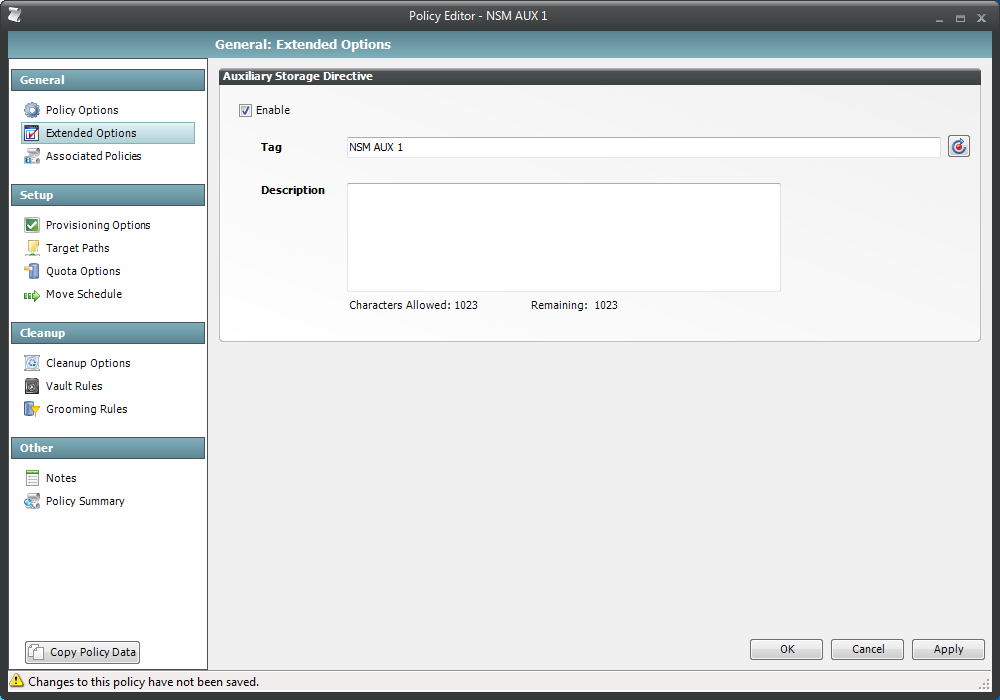B.0 AuxMap
The AuxMap utility lets you map drive letters to a user’s auxiliary storage folders through command line parameters in a Novell Client login script. When the user logs in to eDirectory, AuxMap reads the auxiliary attribute associated with each auxiliary storage folder assigned to the user and then enables the drive mappings.
AuxMap is supported on the following Windows platforms and clients:
-
Windows Vista, Windows Server 2008, Windows Server 2008 R2, Windows Server 2012, or Windows 7 with Novell Client 2 SP1 for Windows
-
Windows XP SP2 or later with Novell Client 4.91 SP2 or later.
AuxMap is supported on the following Linux platforms and clients:
-
SUSE Linux Enterprise Desktop 10.2 or later with Novell Client for Linux 2 SP1
-
SUSE Linux Enterprise Server 10.2 or later with Novell Client for Linux 2 SP1
You must have the check box checked, and an entry in the field of the Extended Options of an auxiliary storage policy.
Figure B-1 Extended Options Page of an Auxiliary Storage Policy

For more information, see Enabling Auxiliary Storage Extended Options.
At the root of the ISO, go to the applicable path to locate AuxMap:
-
\Windows\x86\AuxMap.exe
-
\Windows\x86_64\AuxMap.exe
-
\SLES10\i586\auxmap
-
\SLES10\i586_64\auxmap
-
\SLES101\i586\auxmap
-
\SLES11\i586_64\auxmap
Example usage:
AuxMap [--tree=<eDir-tree-name>] --drive=<drive-letter> --storage=<storage-name>
AuxMap [-t=<eDir-tree-name>] -d=<drive-letter> -s=<storage-name>
AuxMap --delete --drive=<drive-letter>
AuxMap --list-mappings
The following command line switches are supported:
Table B-1 AuxMap Command Line Switches
--help or -? |
Displays command line switch help information for AuxMap. |
--list-mappings or -lm |
Lists all currently mapped network drives. |
--drive=<drive-letter-or-path>
or
-d=<drive-letter-or-path>
|
On a Windows workstation, this must be a single uppercase letter in the range A through Z. On a Linux workstation, this can be a single uppercase letter in the range A through Z, in which case a symbolic link named for the drive letter will be created in the user's home directory on the Linux desktop. A path can also be specified, in which case a symbolic link will be created exactly as specified by the path value. In all cases, the symbolic link that is created will refer to the storage resource that has been connected under the /var/opt/novell/nclmnt/<username>[/<path>] directory. |
--storage=<storage-name>
or
-s=<storage-name>
|
This must be the name of an auxiliary storage area that has been provisioned for the user and that is currently enabled and specified in the field of the of the Extended Options page of the auxiliary storage policy. If the string in the field contains a space, you must have quotes around the auxiliary storage area name. For legacy environments that are running a version of Novell Storage Manager prior to version 3.0, this could also be the fully distinguished name of an auxiliary storage policy object in eDirectory. |
--tree=<tree-name>
or
-t=<tree-name>
|
Specifies the eDirectory tree name where Novell Storage Manager will look for auxiliary storage information. |
--delete |
Performs a map delete on the specified drive letter or path. Use with the --drive or -d switches. |
--debug |
If present, this causes AuxMap to produce more detailed diagnostic logging as it executes. |
The following command line switches are ignored if present. They were valid in versions prior to Novell Storage Manager 3.0, but they are no longer applicable.
Table B-2 Ignored Command Line Switches
--root or -r |
Deprecated. All mappings are map-rooted. |
--force or -f |
Deprecated. The drive letter or path will always be unmapped (if it is currently mapped) before being mapped. |
--quiet or -q |
Deprecated. Redirect the output by using >NUL: 2>NUL: to suppress all console output. |
--log=<log-file>
or
-l=<log-file>
|
Deprecated. Redirect the output using >filename or 2>filename. |